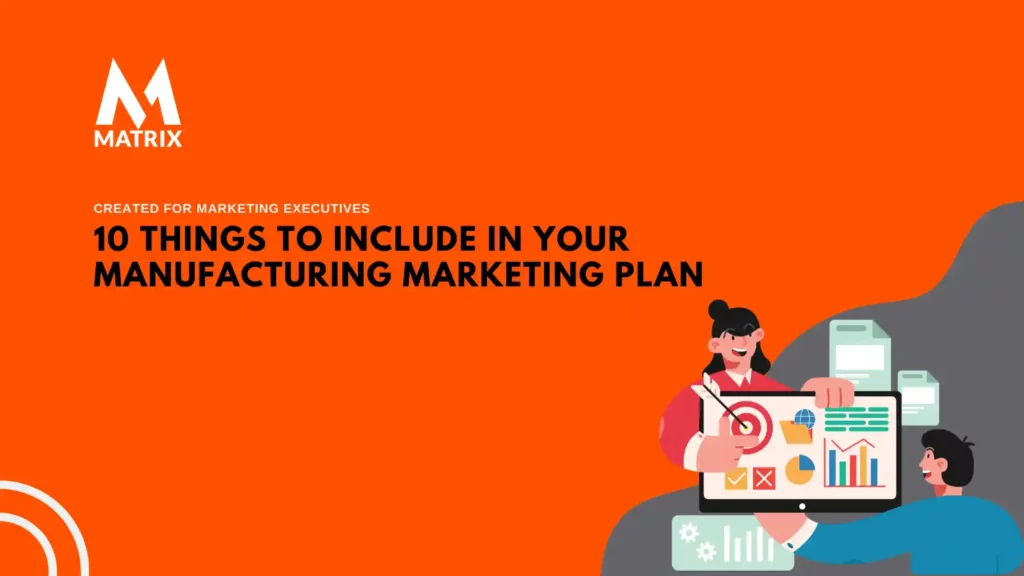10 Vital Things to Include in your Manufacturing Marketing Plan
Learn the Top Ten Things to Include in your Manufacturing Marketing Plan.
A manufacturing marketing plan is important for any industrial business. It allows it to set clear goals and projections for its sales and growth. Therefore, when creating the plan, it’s necessary to include three distinct areas of information.
The Importance of a Manufacturing Marketing Plan

In today’s competitive manufacturing landscape, a well-crafted marketing plan is essential for any company that wants to thrive. A manufacturing marketing plan is a strategic roadmap guiding the company’s marketing efforts to achieve its business objectives. It outlines the company’s target audience, key messaging, marketing channels, and measures for success.
Key Benefits of a Manufacturing Marketing Plan
- Increased Brand Awareness and Reputation: A strong marketing plan elevates the company’s brand awareness and establishes its reputation as a reliable and innovative manufacturer.
- Lead Generation and Sales Growth: A well-defined plan attracts potential customers and generates qualified leads, ultimately driving sales growth and revenue expansion.
- Customer Acquisition and Retention: Effective marketing strategies foster customer loyalty and encourage repeat business, leading to long-term customer relationships and sustainable growth.
- Market Differentiation and Competitive Advantage: A clear differentiation strategy sets the company apart, highlighting its unique value proposition and attracting a loyal customer base.
- Strategic Resource Allocation and Cost-Effectiveness: A comprehensive plan ensures that marketing resources are allocated efficiently, maximizing ROI and minimizing unnecessary expenses. Top 7 Challenges Facing SEO Managers in 2025
Google Ads Checklist – Download Now! 🚀
Struggling to get the most out of your Google Ads? 🔥 Download our Google Ads Optimization Checklist and take your campaigns to the next level!
✅ Maximize Clicks & Conversions
✅ Lower Your Cost-Per-Click (CPC)
✅ Improve Ad Quality Scores
✅ Target the Right Audience
This free checklist will help you set up, optimize, and scale your Google Ads campaigns for maximum ROI.
Essential Components of a Manufacturing Marketing Plan
- Situational Analysis: The plan’s foundation is a thorough understanding of the company’s internal strengths and weaknesses and external market opportunities and threats.
- Target Audience Definition: Identifying the company’s ideal customer personas, including their demographics, needs, and preferences, guides the development of targeted marketing campaigns.
- Marketing Goals and Objectives: Clearly defined goals and objectives provide direction and enable marketing effectiveness measurement.
- Marketing Strategies and Tactics: A detailed outline of marketing strategies, such as content marketing, social media engagement, and email campaigns, aligns with the overall plan.
- Marketing Budget and Resource Allocation: A realistic budget breakdown ensures that resources are allocated effectively to support the marketing plan’s implementation.
- Marketing Metrics and Performance Measurement: Establishing key performance indicators (KPIs) allows the company to track the effectiveness of its marketing efforts and make data-driven decisions.
A manufacturing marketing plan is not a static document; it should be continuously reviewed and updated to adapt to changing market conditions, customer preferences, and technological advancements. By investing in a well-developed and executed marketing plan, manufacturing companies can effectively navigate the competitive landscape, achieve their business goals, and secure a sustainable future in the industry.
First, companies must decide on their product or service offerings and target market. This should include long-term and short-term goals so the plan can adjust as the business’s customer base evolves.
Secondly, any marketing plan should include a good strategy—this should include a description of how the company intends to reach out to its potential customers and how it will motivate them to purchase.
Finally, resources should be allocated properly to facilitate the effective implementation of the plan– this includes budgeting for marketing materials, developing campaigns, and training staff on customer service procedures.
By including all these elements in the manufacturing marketing plan, businesses can ensure that they create a blueprint that will provide them with success models and lay the foundations for growth. Companies can maximize their potential by implementing successful strategies to achieve meaningful results by emphasizing these components.
With comprehensive planning, businesses can move confidently into the future with clarity and focus. Therefore, taking time to create an effective Manufacturing Marketing Plan is always a key step for any business that wants to succeed in today’s competitive market environment.
We put the first five steps of our manufacturing marketing plan into place a couple of weeks ago.
We considered the overall account strategy and then started diving into each section’s tactical underlying processes. To recap, we discussed the importance of the following:
- Situational Review
- Current Marketing Report
- S.M.A.R.T Goals
- Buyer Personas & Target Audience
- Software Stack Selection
Return on Investment (ROI) from Thought Leadership SEO
Thought leadership SEO campaigns, which involve strategic planning and high-quality content creation, have demonstrated a return on advertising spend (ROAS) of 9.10, equating to a 748% ROI, with a typical break-even point at around 9 months. Review how to win with SEO Services.
Snapshot
The first half of your manufacturing marketing plan must be airtight before moving on to the next step. Within the succeeding section, we will begin to review the significance of:
- Inbound Marketing Activities
- Outbound Marketing Activities
- Sales & Marketing Process Identification
- Marketing Budget
- Measure Return on Investment
6. Inbound Marketing Activities
Marketing has been relatively straightforward in its history. Inbound is simple industry jargon for a core activity base, resulting in a positive and constructive buyer’s journey. The buyer’s journey is the act of turning strangers into paying customers and even self-promoters.
Hubspot has done a great job breaking this process into four phases: Attract, Convert, Close, and Delight.
Inbound beds marketers operate around the same actions we take to build relationships. People will not inherently like or trust you, so giving them a reason is important. So, what activities build a company’s authority and trustworthiness? Each of these could use their article to explain, but here is a quick run-through:
Attract Phase
Sure, here is an explanation of the Attract Phase of the Inbound Marketing Methodology:
The Attract Phase: Drawing Visitors to Your Website
The Attract Phase is the first stage of the Inbound Marketing Methodology, which is a framework for attracting, engaging, delighting, and repeating customers. The attraction phase aims to draw visitors to your website by creating valuable and relevant content that appeals to your target audience.
Key Strategies for the Attract Phase:
- Develop Buyer Personas: Understand your ideal customer’s demographics, interests, challenges, and buying behaviors to create content that resonates with them.
- Conduct Keyword Research: Identify relevant keywords that people are searching for related to your products or services to optimize your content and attract organic traffic.
- Create High-Quality Content: Produce informative, engaging, and shareable content that educates, entertains, and addresses your audience’s pain points.
- Optimize Your Website: Ensure your website is user-friendly, mobile-responsive, and search engine optimized (SEO) to enhance its visibility and attract visitors.
- Utilize Social Media Platforms: Actively engage on social media platforms where your target audience is present, sharing your content and building relationships with potential customers.
Measuring Success in the Attract Phase:
- Website Traffic: Track the number of visitors to your website, analyzing traffic sources and user behavior to understand how visitors find your content.
- Lead Generation: Measure the number of leads generated through website forms, content downloads, or newsletter subscriptions.
- Content Engagement: Monitor metrics like page views, time on page, and social media shares to assess the engagement level of your content.
- Brand Awareness: Evaluate brand awareness by tracking mentions, social media engagement, and referral traffic from other sources.
Continuous Improvement in the Attract Phase:
- Analyze Data: Regularly review data from website analytics, social media insights, and marketing automation tools to identify trends, areas for improvement, and opportunities for optimization.
- Adapt Content Strategy: Refine your content strategy based on insights gained from data analysis, incorporating new trends, audience preferences, and evolving keywords.
- Experiment with New Channels: Explore emerging marketing channels and technologies to reach your audience innovatively.
- Stay Updated: Keep abreast of industry trends, algorithm changes, and best practices to ensure your Attract Phase strategies remain effective and aligned with the evolving digital landscape.
- Blogging
- Social Networking
- Website Development
- Search Engine Optimization
These outlines have one thing in common: driving SPECIFIC traffic to your product or services. As a manufacturer, why would you want somebody on your site looking to purchase a pizza? The short answer is you clearly wouldn’t. The right people are the designated buyer personas we created previously.
Affordable SEO Solutions That Drive Real Results
Matrix Marketing Group Delivers Customized SEO Strategies with Transparent Pricing for Maximum ROI. See SEO Services.
Convert Phase
The second stage of inbound marketing methodology is the conversion phase. It follows the Attract phase, which aims to draw visitors to your website or other online channels. Once you have attracted visitors, the Convert phase turns them into leads by capturing their contact information.
The key objectives of the Convert phase are to:
- Identify and capture leads: This involves creating compelling offers that entice visitors to exchange their contact information for valuable content or resources.
- Nurture leads into qualified prospects: Once you have captured leads, you must nurture them through a series of personalized interactions to educate them about your offerings and move them closer to becoming paying customers.
- Qualify leads for sales: By understanding the needs and interests of your leads, you can qualify them to determine which ones are most likely to convert into customers and should be prioritized by your sales team.
Effective Convert phase strategies include:
- Creating high-quality landing pages: Landing pages are dedicated web pages that capture leads. They should be optimized for conversions with clear calls to action, engaging content, and relevant forms.
- Utilizing lead magnets: They are irresistible offers that entice visitors to provide their contact information. Examples include downloadable guides, webinars, or discounts.
- Implementing email marketing automation: Email automation allows you to nurture leads with personalized email sequences that deliver relevant content and guide them through the sales funnel.
- Integrating with CRM systems: A CRM (customer relationship management) system helps you organize and manage lead data, track interactions, and measure the effectiveness of your nurturing efforts.
- Analyzing lead conversion data: Regularly monitor lead conversion rates and identify areas for improvement to optimize your conversion phase strategies.
The Convert phase plays a critical role in the inbound marketing methodology. It transforms website visitors into valuable leads that can be nurtured and converted into paying customers. By implementing effective Convert phase strategies, businesses can drive growth and achieve their sales goals. How to Use AI Digital Marketing to Transform Your Marketing Results
- Landing Pages
- Forms
- Call-to-Actions
Getting the right eyes on your website is great, but if these visitors aren’t submitting contact information, you miss out on the most valuable marketing currency. You must provide beneficial information or goods to which your target market will relate.
Not gaining a viewer’s information is the equivalent of watching a potential customer walk out of your brick-and-mortar storefront without a purchase. Automated Keyword Discovery: A Game Changer for SEO
Transform Your Digital Presence with a Single Click
Are you ready to elevate your brand and drive exceptional growth? At Matrix Marketing Group, we blend creativity with data-driven strategies to deliver cutting-edge digital marketing solutions. Book your free consultation today and discover how we can help you connect, engage, and convert your audience like never before.
Close Phase
The close phase is the final stage in the sales cycle, where the salesperson attempts to secure a commitment from the prospect to purchase the product or service. This phase is crucial for converting leads into paying customers and achieving sales targets.
Key Objectives of the Close Phase
- Address any remaining objections: The salesperson should proactively address the prospect’s lingering concerns or doubts. This involves active listening, empathy, and providing clear and concise explanations.
- Summarize the value proposition: Concisely reiterate the key benefits and advantages of the product or service to the prospect. This reinforces the value proposition and aligns the prospect’s needs with the solution.
- Ask for the sale: Clearly and confidently ask the prospect for their purchase commitment. This direct approach demonstrates confidence in the product and the salesperson’s belief in its ability to solve the prospect’s problems.
- Handle objections and negotiation: Respond professionally and flexibly to objections or negotiation attempts. The salesperson should aim to find a mutually agreeable solution that benefits both parties.
- Close the deal: Once the prospect agrees to purchase, finalize the transaction by completing the necessary paperwork and providing any required documentation.
Effective Close-Phase Strategies
- Build rapport and trust: Throughout the sales process, cultivate a strong relationship with the prospect. This builds trust and makes them more receptive to the salesperson’s recommendations.
- Understand the prospect’s needs: Thoroughly understand the prospect’s specific needs, challenges, and goals. This allows for tailoring the sales pitch and directly addressing their pain points.
- Position the product as a solution: Frame the product or service as a solution that directly addresses the prospect’s identified needs and challenges. Demonstrate how it can solve their problems and improve their situation.
- Create a sense of urgency: Convey the importance of acting now and the potential benefits of taking immediate action. This can encourage the prospect to make a swift decision.
- Use testimonials and case studies: Share success stories and testimonials from other satisfied customers. This provides social proof and reinforces the product’s effectiveness.
- Offer incentives and discounts: Consider offering limited-time promotions or discounts to incentivize the prospect to purchase.
- Be confident and enthusiastic: Exude confidence and enthusiasm for the product or service. This conveys professionalism and belief in its value.
- Be persistent and follow up: Don’t give up after the initial presentation. Follow up with the prospect to address lingering concerns and reinforce the value proposition.
- Marketing Automation Technology
- Inbound Email Workflows
- Sales & Marketing Alignment
You have the right target market and convert visitors into viable leads. Still, nobody is satisfied until you have paying customers coming in, and persuading leads to switching to purchasing your products, which is part of creativity and data analysis. There are an endless number of marketing automation tools to support this process.
These systems can be utilized for lead nurturing, email marketing, contact tracking, content creation, etc. Site Speed Optimization: Better User Experience
Delight
The Delight phase is the final stage of the inbound marketing methodology, encompassing Attract, Convert, Close, and Delight. While the first three stages focus on attracting, converting, and closing potential customers, the Delight phase centers on providing exceptional experiences for existing customers to foster long-term loyalty and advocacy. How to Choose the Right AI Digital Marketing Agency: A Comprehensive Guide for Marketing Managers
Key Objectives of the Delight Phase
- Exceed Customer Expectations: The Delight phase aims beyond simply meeting customer expectations; it strives to deliver remarkable experiences that exceed expectations and turn customers into raving fans.
- Nurture Customer Relationships: By consistently providing exceptional service and value, companies can build strong, lasting relationships with their customers, fostering trust and loyalty.
- Encourage Customer Advocacy: Delighted customers become brand advocates, promoting the company’s products and services to their networks and generating positive word-of-mouth marketing.
- Drive Repeat Business and Increased Customer Lifetime Value: Satisfied customers are more likely to return for repeat purchases, leading to increased customer lifetime value (CLTV) and revenue growth.
Strategies for Implementing the Delight Phase
- Gather Customer Feedback: Actively seek customer feedback through surveys, interviews, and social media interactions to understand their perceptions, pain points, and expectations.
- Personalize Customer Interactions: Leverage customer data to personalize interactions, tailoring communications, recommendations, and offers to individual preferences.
- Anticipate and Address Customer Needs: Proactively anticipate customer needs and provide solutions before they ask, demonstrating attentiveness and care.
- Go the Extra Mile: Surprise and delight customers with unexpected gestures, such as birthday greetings, exclusive offers, or special thank-you notes.
- Create a Customer-Centric Culture: Foster a company culture that values customer satisfaction, empowering employees to go above and beyond to exceed expectations.
Metrics for Measuring Delight Phase Success
- Customer Satisfaction (CSAT) Scores: Track CSAT scores to gauge overall customer satisfaction with the company’s products, services, and interactions.
- Net Promoter Score (NPS): Measure NPS, which indicates the likelihood of customers recommending the company to others, reflecting their level of loyalty and advocacy.
- Customer Retention Rate: Monitor customer retention rates to assess the company’s ability to keep existing customers and prevent churn.
- Customer Lifetime Value (CLTV): Track CLTV to measure the long-term financial value of each customer, indicating the company’s ability to generate repeat business.
- Positive Customer Reviews: Analyze online reviews and social media comments to gauge customer sentiment and identify areas for improvement.
By prioritizing the Delight phase and implementing effective strategies, companies can cultivate a loyal customer base, drive repeat business, and achieve sustainable growth. Delighting customers is not just about fulfilling their needs; it’s about building relationships, exceeding expectations, and creating a brand that customers love.
- Social Monitoring
- Surveys
- Smart Dynamic Content
If you forget about clients once they’ve handed over their payments, you’ll miss out on a great opportunity to upsell or cross-sell. Engaging with customers after the fact builds an invested fan base. Some of the best companies on Twitter regularly connect with their followers.
7. Outbound Marketing Activities
There are common debates on the differences between inbound and outbound marketing techniques.
Inbound marketing involves nurturing leads that have come to you organically, while outbound marketing generates new leads by actively stepping outside your direct sphere of influence. Therefore, a comprehensive manufacturing marketing plan will consist of a combination of these actions.
There is some overlap here and there, but the most typical outbound marketing activities are:
- PPC Advertising
- Email & Direct Mailing
- Guest Appearances
- Print, TV, & Radio Advertising
- Events & Tradeshows
- Press Releases
- Social Media (a cross between inbound and outbound)
Inbound marketing builds a foundation for launching marketing campaigns, while outbound marketing is a leaf in the stream, only there as long as you continue to pay for it. Nonetheless, it helps communicate messages to a wider audience. Any healthy marketing plan will have a mixture of both inbound and outbound. Rethinking AI Website Design in the Age of the Algorithm
8. Sales and Marketing Process Identification
Numerous variables to balance our day-to-day motions often get overlooked or forgotten altogether.
That is why creating a sales and marketing process is on our list. It’s time to determine what measurable, scalable, and actionable activities will lead a business to the best process for its pursuits. The process you build should have a clear and unifying purpose for all future sales and marketing efforts.
Begin thinking of your marketing as a constant flow of connected actions. Marketing will not be beneficial in sporadic, one-off projects. If continuity is the goal, marketers must outline each project’s steps to complete all future efforts.
Layout your marketing projects in a process roadmap format. This valuable tool creates repeatability, team alignment, and visibility to find improvements. Think about where each plan starts, who is responsible, what steps are involved, and the checks & balances in between. AI Marketing Plan for Manufacturing Businesses
Be detailed and thorough so that the next person to view your process can work through it without outside instruction. Here is an example of what Matrix Marketing Group goes through:
How-To: Setting up the client’s new Facebook Page
Account Manager (5 mins)
Find a name that is free on every social platform
Use Name Checker
Account Manager (10 mins)
Create a Business page & add administrators
Account Manager (30 mins)
Complete the ‘About’ Section with detailed business information
Website URL should be the first thing listed
List other social channels predominantly used
Fully complete all Fields (founded date, site(s), products, services, company mission, overview, and description)
Account Manager (30 mins)
Create Cover Photo & Profile Photo
Correct Image Sizes To Use Here
Account Manager (15 mins)
Add Industry Appropriate CTA
Account Manager (10 mins)
Add company milestones & KPIs discussed with the client.
Account Manager (15 mins)
Find pages to like that match ICP and Buyer Personas
Account Manager (15 mins)
Add to/Create a Social Media management account – confirm with the client beforehand.
Account Manager (10 mins)
Publish the first status update/wall post
Are these steps perfect? Probably not, but they provide a solid base for the account managers to start their Facebook Page creation process. They are meant to be adaptable to the situation but still easily understood.
9. Marketing Budget
The average small to midsize company spends 10 – 15% of yearly revenue on its marketing. Of course, mega-corporations like Coca-Cola have a cool $2 billion budget. It’s hard to compete against that kind of cold, hard cash, so we marketers with a tighter budget must be extremely conscientious of what leads our efforts are generating and where the focus should be shifted.
Either way, all organizations use the same budget allocation process, regardless of size or industry. If you rewind to the third step in our manufacturing marketing plan, you’ll remember the S.M.A.R.T Goals we discussed. Are you focusing on lead generation, product awareness, content creation, or another combination? These goals that you set up should have a strong influence on where your marketing budget is spent. Consider the different inbound and outbound marketing activities best suit your objectives and map that to an allocated master budget.
Here is an excellent example of estimated items by month and the actual comparative spend. This master budget is meant for a broad picture view, a 3,000-foot screenshot. You can always blow out each category under new tabs to get more definitive granularity.
10. Measure Return on Investment
If you don’t measure your marketing’s ROI, you have a serious problem. Honestly, you are thrusting money into a mysterious pit with no real solutions or advancements coming from your troubles. It almost seems counter-intuitive; marketing budgets are tighter than ever, yet a large chunk of B2B markets doesn’t measure their results!
The process doesn’t have to be difficult, either. Begin by selecting an analytics tool; the most widely used is Google Analytics. If you choose this tool, I highly suggest you take the training course and become certified; it is an incredibly in-depth solution. Add a tracking code to the company’s website to start tracking results.
Then, define the KPIs that matter to your campaign progression. At Matrix Marketing, we track over 80+ metrics for our operations, which are always evolving. There’s no need to track all these metrics at once. Just pick the most relevant ones for your business.
The best part of our manufacturing marketing plan is that once you have collected the ROI data, you can use it to return to the beginning, find the weak points, and readjust accordingly.
Today’s marketing is all about trial and error, with data points to back everything up. Go to the beginning, fix the items that didn’t work, and walk through the steps again.
What would you add to your manufacturing marketing plan to make it stand out? Please share additional tips and tricks in the comment section below!
You might be interested in the following: Is There Any Way to Close Deals in Today’s Corporate Marketplace? [Part I]





